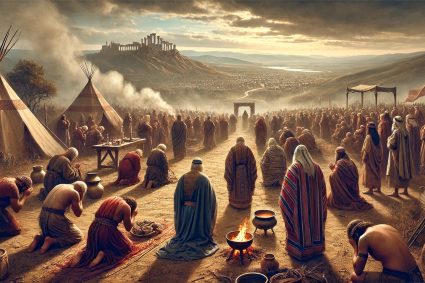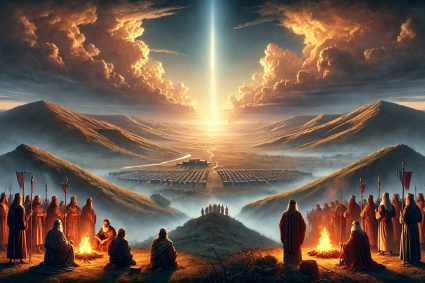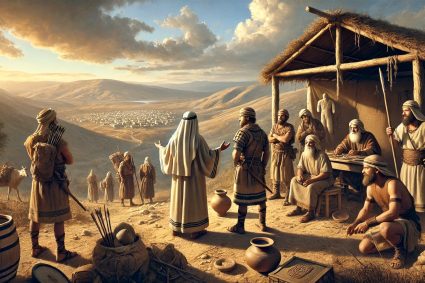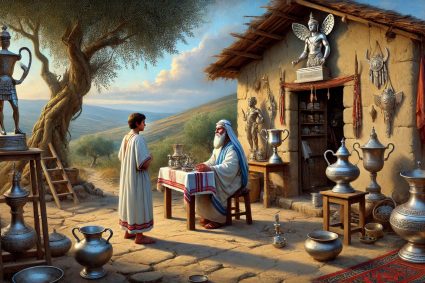
July 5, 2024
Message of the Book of Habakkuk
The biblical Book of Habakkuk is one of the twelve minor prophets in the Old Testament. It differs from other prophetic books through its dialogue style between the prophet Habakkuk and God. The main messages of the Book of Habakkuk can be divided into several central themes:
Key Messages of the Book of Habakkuk:
-
The Problem of Evil and God’s Justice: Habakkuk begins with a lament about the injustice and suffering he sees in Judah. He asks God why He allows wrongdoing and violence. This question about the problem of evil and God’s justice is a central theme of the book.
-
God’s Answer and Judgment on Babylon: God responds to Habakkuk by announcing that He will use the Babylonians (Chaldeans) to punish Judah for its sins. This leads to another question from Habakkuk: How can a just God use such a cruel and wicked nation to punish His people? God answers that the Babylonians will also be judged for their actions.
-
Faith and Righteousness: A key verse in the Book of Habakkuk is “The righteous shall live by his faith” (Habakkuk 2:4). This statement emphasizes the importance of faith and trust in God, even amid injustice and suffering. It is a call for believers to rely on God’s wisdom and plan, even when circumstances are difficult to understand.
-
The Vision and Assurance of God’s Plan: God gives Habakkuk a vision and instructs him to write it down so it can be made known. This vision affirms that God’s judgment is certain and inevitable, even if it takes time. It encourages believers to be patient and trust in God’s timing.
-
God’s Sovereignty: Habakkuk acknowledges God’s sovereignty and control over the nations. The book ends with a prayer of the prophet, in which he recognizes God’s power and glory. Habakkuk chooses to trust in God, regardless of the circumstances.
-
Comfort and Hope: Despite the severe message, the book offers comfort and hope. Habakkuk’s concluding prayer in Chapter 3 expresses his trust in God’s salvation, even when external circumstances seem hopeless. Habakkuk 3:17-19 shows his unwavering faith that God will ultimately take care of His people.
Summary
The Book of Habakkuk addresses questions about God’s justice in the face of evil and suffering. It shows the dialogue between the prophet and God, with Habakkuk’s questions and God’s answers providing a deep theological reflection on faith, justice, and God’s sovereignty. The central thought “The righteous shall live by his faith” underscores the necessity of trusting in God’s plan and wisdom, even when circumstances are hard to understand. Habakkuk’s concluding prayer and his trust in God’s salvation offer comfort and hope to believers that God will ultimately act justly and redeem His people.
DAILY BIBLE READING – Habakkuk Chapter 1
1 The burden which Habakkuk the prophet did see.
2 O Lord, how long shall I cry, and thou wilt not hear! even cry out unto thee of violence, and thou wilt not save!
3 Why dost thou shew me iniquity, and cause me to behold grievance? for spoiling and violence are before me: and there are that raise up strife and contention.
4 Therefore the law is slacked, and judgment doth never go forth: for the wicked doth compass about the righteous; therefore wrong judgment proceedeth.
5 Behold ye among the heathen, and regard, and wonder marvelously: for I will work a work in your days which ye will not believe, though it be told you.
6 For, lo, I raise up the Chaldeans, that bitter and hasty nation, which shall march through the breadth of the land, to possess the dwellingplaces that are not their’s.
7 They are terrible and dreadful: their judgment and their dignity shall proceed of themselves.
8 Their horses also are swifter than the leopards, and are more fierce than the evening wolves: and their horsemen shall spread themselves, and their horsemen shall come from far; they shall fly as the eagle that hasteth to eat.
9 They shall come all for violence: their faces shall sup up as the east wind, and they shall gather the captivity as the sand.
10 And they shall scoff at the kings, and the princes shall be a scorn unto them: they shall deride every strong hold; for they shall heap dust, and take it.
11 Then shall his mind change, and he shall pass over, and offend, imputing this his power unto his god.
12 Art thou not from everlasting, O Lord my God, mine Holy One? we shall not die. O Lord, thou hast ordained them for judgment; and, O mighty God, thou hast established them for correction.
13 Thou art of purer eyes than to behold evil, and canst not look on iniquity: wherefore lookest thou upon them that deal treacherously, and holdest thy tongue when the wicked devoureth the man that is more righteous than he?
14 And makest men as the fishes of the sea, as the creeping things, that have no ruler over them?
15 They take up all of them with the angle, they catch them in their net, and gather them in their drag: therefore they rejoice and are glad.
16 Therefore they sacrifice unto their net, and burn incense unto their drag; because by them their portion is fat, and their meat plenteous.
17 Shall they therefore empty their net, and not spare continually to slay the nations?
King James Version. Public Domain
Commentary
Habakkuk 1 is a powerful chapter that portrays the prophet’s lament over the injustice and suffering in the world. Habakkuk begins with a heart-wrenching cry to God, complaining about the prevailing violence and injustice. He asks why God allows suffering and misery and why the law seems powerless while the wicked overpower the righteous (verses 1-4).
In the following verses (5-11), God responds and explains that He will raise up the Chaldeans (Babylonians), a cruel and powerful nation that will sweep across the earth and seize dwellings not their own. God describes the Chaldeans as terrifying warriors, whose horses are swifter than leopards and whose horsemen are numerous and unstoppable. This nation will mock kings and conquer fortresses, but ultimately, their own strength will become their god.
In the concluding verses (12-17), Habakkuk turns to God again and questions His justice. He reminds God that His eyes are too pure to look on evil and wonders why He allows the wicked to swallow up the righteous. Habakkuk uses the imagery of fishermen who catch their prey with nets to illustrate the injustice. These fishermen (the Chaldeans) rejoice in their success and sacrifice to their nets, which bring them wealth and power.
In summary, Habakkuk 1 shows the prophet’s inner struggle as he tries to understand how God can allow suffering and injustice in the world. It is a profound engagement with the problem of evil and divine justice, a theme frequently addressed in the Bible. Habakkuk’s questions and God’s answers provide an honest and powerful reflection on faith, doubt, and the pursuit of justice in a fallen world.
![]()

WEEKLY SPIRIT OF PROPHECY READING – Ellen White | The Desire of Ages Chapter 42: Tradition
This chapter is based on Matthew 15:1-20; Mark 7:1-23.
Read online here.
Commentary
Background and Context:
Chapter 42 addresses the confrontation between Jesus and the Pharisees as well as the scribes who intended to trap him. The Pharisees and scribes were eager to accuse Jesus of disregarding the traditional regulations, particularly concerning ritual cleansings. These regulations, created as protective measures around God’s law, had become so significant over time that they overshadowed the actual commandments of God.
The Accusation of the Pharisees and Scribes:
The Pharisees and scribes confront Jesus and ask him why his disciples transgress the traditions of the elders by not washing their hands before eating (Matthew 15:2). This question indicates that the religious leaders valued human traditions more than God’s actual commandments.
Jesus’ Response and True Purity:
Jesus does not directly defend himself or his disciples but points out the hypocrisy of the Pharisees. He quotes Isaiah to highlight their hearts’ distance from God (Matthew 15:7-9). Jesus emphasizes that what comes from outside into a person does not defile them, but what comes from the heart does. Evil thoughts, words, and deeds are the true source of defilement, not the neglect of external, man-made ordinances.
Criticism of Human Traditions:
Jesus makes it clear that the Pharisees and scribes nullify God’s commandments through their traditions. An example of this is the practice of refusing support to parents by declaring possessions as “Korban” (offering). This practice illustrates how human traditions are misused to circumvent divine commandments (Mark 7:9-12).
Resistance and Hostility:
The Pharisees’ reaction to Jesus’ words is anger, as they see their falsehood and hypocrisy exposed. Jesus points out that human customs and traditions not originating from God are ultimately worthless and will be uprooted (Matthew 15:13).
Relevance and Application:
Even today, people tend to place human traditions and customs above God’s commandments. This tendency often leads to hostility towards those who point out the flaws in such practices. In modern Christian practice, many institutions and traditions have no better foundation than the traditions of the fathers. It is crucial that we rely on God’s word and not be distracted by human regulations.
Summary:
Chapter 42 illuminates the dispute between Jesus and the religious leaders of his time regarding the importance of traditions compared to God’s commandments. Jesus emphasizes the importance of inner purity and adhering to divine commandments over human traditions. This teaching remains relevant, reminding us that true purity and obedience to God come from the heart and are not determined by external rituals or human regulations.

WEEKLY SPIRIT OF PROPHECY READING – Ellen White | The Desire of Ages Chapter 43: Barriers Broken Down
This chapter is based on Matthew 15:21-28; Mark 7:24-30.
Read online here.
Commentary
Background and Context:
After his encounter with the Pharisees, Jesus withdraws from Capernaum and travels to the region of Tyre and Sidon to find seclusion and rest. This journey not only aims for rest but also serves to prepare his disciples for their future mission, which will extend beyond the borders of Israel. Jesus uses this opportunity to teach his disciples important lessons about grace, faith, and the universality of the gospel.
The Encounter with the Canaanite Woman:
Verses 21-22: The Canaanite woman who approaches Jesus presents a remarkable contrast to the religious leaders who have just challenged him. She is a Gentile, despised and excluded by the Jews, yet she shows deep faith and remarkable persistence by asking Jesus to heal her daughter. Her address, “Lord, Son of David,” indicates her recognition of his messianic role.
The Testing of Faith:
Jesus initially ignores the woman’s plea and gives her an apparently dismissive response. This reaction may seem harsh or heartless but serves a deeper purpose. Jesus wants to highlight to his disciples the prevalent prejudices and the harsh attitude of the Jews towards Gentiles. At the same time, he tests the woman’s faith and gives her the opportunity to demonstrate her steadfast faith and humility.
The Woman’s Response:
Despite the dismissive words, the woman remains undeterred. She seizes the opportunity and responds with remarkable humility and faith, saying that even the dogs eat the crumbs that fall from the children’s table. This response shows that she not only claims God’s grace for herself but also understands his mercy and love that transcend all cultural and ethnic boundaries.
Jesus’ Reaction:
Impressed by her faith and humility, Jesus grants her request and heals her daughter. This action clearly demonstrates that God’s grace and healing are accessible to all, regardless of their background or status. It is a powerful example of overcoming prejudices and the inclusiveness of the gospel.
Lessons for the Disciples:
Jesus uses this encounter to teach his disciples several important lessons:
-
Faith and Persistence: The unwavering faith and persistence of the woman serve as a model for the disciples and all believers.
-
Universality of the Gospel: Jesus shows that his mission and the message of the gospel are not limited to the Jewish people but are meant for all humanity.
-
Overcoming Prejudices: The encounter teaches the disciples to recognize and overcome their own prejudices and those of their culture.
Far-reaching Significance:
This event has far-reaching implications for understanding Jesus’ mission and the role of the disciples. It shows that the gospel is meant to break down barriers of race, culture, and religion, and that faith and humility are the key factors in receiving God’s grace.
Relevance and Application:
Even today, social, cultural, and religious barriers exist that separate people. The lessons from this story remind us that God’s love and grace are accessible to all people and that we as believers are called to carry this message of inclusivity and mercy to the world.
Conclusion:
The story of Jesus and the Canaanite woman is a powerful testimony to overcoming prejudices and the universal nature of the gospel. It shows that true faith and humility are the keys to receiving God’s grace and that no human barrier is strong enough to limit God’s love and mercy. This teaching is as relevant today as it was then, challenging us to live out and share the universal message of the gospel.

WEEKLY SPIRIT OF PROPHECY READING – Ellen White | The Desire of Ages Chapter 44: The True Sign
This chapter is based on Matthew 15:29-39; Matthew 16:1-12; Mark 7:31-37; Mark 8:1-21.
Read online here.
Commentary
Background and Context:
In this chapter, we witness the continuation of Jesus’ ministry in non-Jewish areas following his encounter with the Canaanite woman. He traveled through Sidon, came to the Sea of Galilee, and entered the region of the Decapolis. These regions were predominantly inhabited by Gentiles, which makes Jesus’ mission at this time unusual since he had primarily ministered among the Jews.
The Healing of the Deaf-Mute (Mark 7:31-37):
-
Verse 31: Jesus travels from Tyre through Sidon to the Sea of Galilee, into the region of the Decapolis. This movement shows that Jesus is also working in Gentile areas, indicating that his message and healings are not limited to the Jews.
-
Verses 32-35: People bring a deaf-mute man to Jesus and beg him to heal him. Jesus takes the man aside, puts his fingers in the man’s ears, and touches his tongue. These physical actions demonstrate Jesus’ personal and caring approach. He sighs, looks up to heaven, and says, “Ephphatha” (Be opened). Immediately, the man can hear and speak. This healing not only shows Jesus’ power but also his deep compassion and ability to overcome physical and spiritual barriers.
-
Verses 36-37: Jesus instructs the people not to speak about it, but they spread the news anyway. This shows the overwhelming impact of Jesus’ miracles on the people and their inability to remain silent about such marvelous events.
The Feeding of the Four Thousand (Matthew 15:29-39):
-
Verses 29-31: Jesus goes up a mountain, and a large crowd follows him. They bring the sick and lame to him, and he heals them. These miracles cause the crowd—consisting of Gentiles—to praise the God of Israel. This is remarkable as it shows that Jesus’ works are also recognized among the Gentiles and that God is being praised.
-
Verses 32-39: After the crowd has been with Jesus for three days and has no food left, Jesus expresses his compassion and decides to feed them. The disciples again doubt the possibility of feeding so many people in the wilderness. But Jesus repeats the miracle of feeding: with seven loaves and a few fish, he feeds four thousand men, along with women and children. Seven baskets of leftovers remain. This feeding again shows Jesus’ power and compassion and serves as a model for the disciples that God’s provision is unlimited and extends beyond all cultural boundaries.
The Challenge by the Pharisees and Sadducees (Matthew 16:1-4):
-
Verses 1-4: After returning to Jewish areas, the Pharisees and Sadducees demand a sign from heaven as proof of his divine mission. Jesus rejects this demand and says that no sign will be given except the sign of the prophet Jonah. This response shows that outward signs and miracles alone are not enough to overcome unbelief; it requires an inner change of heart.
Lessons and Application:
-
Faith and Compassion: Jesus’ healing of the deaf-mute and the feeding of the four thousand demonstrate his deep compassion and willingness to help all people, regardless of their background. This teaches us that faith and compassion go hand in hand and that we are called to express our faith through acts of love and care.
-
Overcoming Prejudices: The disciples need to learn to overcome their Jewish prejudices against Gentiles. Jesus’ work in Gentile areas shows that God’s love and grace are accessible to all people. This is an important lesson for us to recognize and overcome prejudices and discrimination in our own lives.
-
The True Sign: Jesus’ response to the Pharisees and Sadducees emphasizes that true signs and wonders are not of an outward nature but consist of an inner change of heart and faith in God’s word. This challenges us to examine our own spiritual lives and ensure that we are not merely seeking outward proofs but striving for a deep and authentic relationship with God.
Summary:
Chapter 44 shows how Jesus breaks down the barriers between Jews and Gentiles, revealing the universal nature of his message and ministry. His healings and miracles in Gentile areas, along with his teachings on true faith, challenge us to overcome our own prejudices and limitations and to develop a deeper, more compassionate, and more authentic relationship with God.
Visited 50 times, 1 visit(s) today






